Orthodox monasticism: Maria’s “good portion” (Lk. 10,42)
5 June 2016[Previous Publication: http://pemptousia.com/2016/06/the-experience-of-tranquility/]
On the occasion of the convocation of the Holy and Great Synod of the Orthodox Church, we are publishing a text by George Mantzaridis, Emeritus Professor of Theology at the Aristotle University of Thessaloniki, which deals with the manner in which Orthodox Theology is produced. This text is a contribution to the more general dialogue which is preceding the discussions of the Pan-Orthodox Synod.
From the beginning, Orthodox monasticism was hesychast. The original monks, living far from the world and practicing unceasing prayer, were, in essence, hesychasts [20]. They felt they had to have recourse to tranquillity ‘in order to speak to God clearly’ [21]. This was and is, however, a self-evident requirement for every real believer. And so we have tranquillity as a basic characteristic of the Church’s outlook. It is the ‘good portion’ of Mary of which Christ Himself approved and which is accentuated and praised in the whole of Orthodox tradition. It also explains the familiarity which the whole of the body of the Orthodox Church has always had with the ascetic tradition, as this is presented in the Filokalia and the texts of Isaac the Syrian, Efraim the Syrian, John of the Ladder, Nikodimos the Athonite and others.

For all Christians, tranquillity is a method of asceticism and a way of life. In the same ways as ethics, the spiritual life of a believer is not presented either monolithically or fragmentarily, but unfolds dynamically through self-abandonment to the will of God. In monasticism, this is achieved through obedience. Passing through the stage of purification from the passions and observance of the commandments, monastics achieve purity of the intellect and heart through obedience. In this way, they experience tranquillity as a state of tranquillity of the mind or of the heart. They experience it as a state of union of the intellect with the heart or as meditation on ‘the hidden person of the heart [22], where it becomes possible to see the reflection of God’s truth. Tranquillity is now no longer ascetic, but, above all, charismatic. It is a state of purity of the soul, in which people are freed of any internal disturbance and disorder, to the point where they transcend themselves and surrender to the contemplation of God. In this state of tranquillity, people become transparent before God, they are known by God, because God wants them and they know God because they are conforming to His will. This is why, as Elder Sophrony writes, in this authentically charismatic life there is no asceticism [23]. In this life, the passions, against which asceticism was a necessary weapon, have already been overcome.
In the field of academic theology, the question is sometimes raised: ‘What Biblical basis is there for hesychasm. What aim does it serve and on what commandment is it based, when, as is well known, all the Gospel commandments are summed up in the double commandment of love?’
The is certainly substance to these questions, but at the same time they have remained unanswered by academic theology. There is, of course, some Biblical support for tranquillity and hesychasm in the text from the Psalms: ‘Be still and know that I am God’ [24]. This has been understood in a practical sense, however, without any further extension or deeper meaning. At least this was how it was understood by the Byzantine humanists who were contemporaries of Saint Symeon the New Theologian. There are also practical examples from Scripture with the Prophet Elijah on Mount Carmel, John the Baptist in the desert, and Jesus Himself, Who withdrew to pray in the tranquillity of the desert [26]. But even these are not thought to be sufficient to justify hesychasm. Many people believe that tranquillity overlooks action. What is not so well understood, however, is that, without tranquillity, action is itself undermined. Without tranquillity the whole salvation of the human race is compromised, because we are not ‘saved’, but still fractured.
In general, neither cataphatic nor apophatic theology finds any real justification for tranquillity and hesychasm. The answer to the question of academic theology should be sought in a kind of meta-theology, which is not unknown in the realm of the Church’s experience. Only there, where the essential relationship between tranquillity and the experience of the content of Christianity can be checked and confirmed- especially the observance of the double commandment of love- can we find an answer to this question. In this way, the ascetic experience of tranquillity and hesychasm offers itself as a field for the meta-theological foundation of Christian theology.
(To be continued)
[20] See John Meyendorff, «Ησυχασμός», Θρησκευτική και Ηθική Εγκυκλοπαιδεία, vol. 6, Athens 1965, col. 83.
[21] See Gregory the Theologian, Λόγος εις εαυτόν 26,7, PG 35, 1237Α.
[22] See I Peter, 3, 4.
[23] Archimandrite Sophrony (Sakharov), We shall see Him as He is, Stavropegic Monastery of Saint John the Baptist, Essex 1988.
[24] Ps. 45, 11.
[25] See Symeon the New Theologian, op. cit. 15,135-138, p. 454.
[26] See Matth. 4, 1; 14, 13. Mk. 1, 12-13; 1, 35. Lk. 4, 1; 5, 16.






